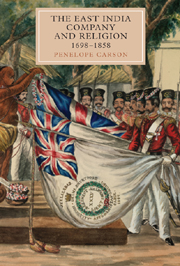Book contents
- Frontmatter
- Contents
- Acknowledgements
- Note on Hinduism
- Abbreviations
- Map of India
- Introduction
- 1 A Christian Company?
- 2 The East India Company, Britain and India 1770–1790
- 3 The 1790s: A Time of Crisis
- 4 The Pillar of Fire Moves Forward: The Advent of British Missionaries 1793–1806
- 5 The Wisdom of the Serpent and the Innocence of the Dove: The Vellore Mutiny and the Pamphlet War 1806–1808
- 6 Troubled Years 1807–1812
- 7 Battle Lines Drawn: Missions, Dissent and the Establishment
- 8 The 1813 Renewal of the Company's Charter: The Religious Public Takes on the Company
- 9 A Turbulent Frontier: The Company and Religion 1814–1828
- 10 A New Dawn? The Era of Lord William Bentinck 1828–1835
- 11 Between Scylla and Charibdis 1836–1858
- Conclusion and Epilogue: Strangers in the Land
- Appendix 1 Presidents of the Board of Control
- Appendix 2 Governors-General and Governors of Madras and Bombay
- Appendix 3 Aide Memoire to Names
- Appendix 4 ‘The Pious Clause’
- Bibliography
- Index
- WORLDS OF THE EAST INDIA COMPANY
2 - The East India Company, Britain and India 1770–1790
Published online by Cambridge University Press: 05 February 2013
- Frontmatter
- Contents
- Acknowledgements
- Note on Hinduism
- Abbreviations
- Map of India
- Introduction
- 1 A Christian Company?
- 2 The East India Company, Britain and India 1770–1790
- 3 The 1790s: A Time of Crisis
- 4 The Pillar of Fire Moves Forward: The Advent of British Missionaries 1793–1806
- 5 The Wisdom of the Serpent and the Innocence of the Dove: The Vellore Mutiny and the Pamphlet War 1806–1808
- 6 Troubled Years 1807–1812
- 7 Battle Lines Drawn: Missions, Dissent and the Establishment
- 8 The 1813 Renewal of the Company's Charter: The Religious Public Takes on the Company
- 9 A Turbulent Frontier: The Company and Religion 1814–1828
- 10 A New Dawn? The Era of Lord William Bentinck 1828–1835
- 11 Between Scylla and Charibdis 1836–1858
- Conclusion and Epilogue: Strangers in the Land
- Appendix 1 Presidents of the Board of Control
- Appendix 2 Governors-General and Governors of Madras and Bombay
- Appendix 3 Aide Memoire to Names
- Appendix 4 ‘The Pious Clause’
- Bibliography
- Index
- WORLDS OF THE EAST INDIA COMPANY
Summary
What is England now? – A sink of Indian wealth, filled by nabobs and emptied by Maccaronis! A senate sold and despised! A country overrun by horse-races! A gaming, robbing, wrangling, railing nation without principles, genius, character or allies.
(Horace Walpole)BY THE 1770s there was growing concern about the way in which the Company was ruling its Indian territories. As the above effusion from Horace Walpole demonstrates, no holds were barred. Language was racist and intemperate and spared no one, least of all the British. As Company wealth and power increased, mounting concerns were expressed about the corruption of Company officials. Returning Company servants were referred to as ‘nabobs’ (a corruption of ‘nawab’ or ruler). These nabobs arrived home laden with Indian riches, which enabled them to buy country estates and purchase parliamentary seats above the ‘going rate’. This was alleged to make entry into British politics even more expensive than it was already. It was widely held that nabobs and their wealth were harmful to political life both in Britain and India. The numbers of nabob MPs rose steadily to about 45 between 1784 and 1790. While they never acted as a combined ‘interest group’ and their ability to affect Indian legislation was, therefore, limited, these nouveaux riches aroused resentment. Fears began to be expressed about the effect that possession of India might have on the British constitution and liberties.
Information
- Type
- Chapter
- Information
- The East India Company and Religion, 1698-1858 , pp. 18 - 33Publisher: Boydell & BrewerPrint publication year: 2012
